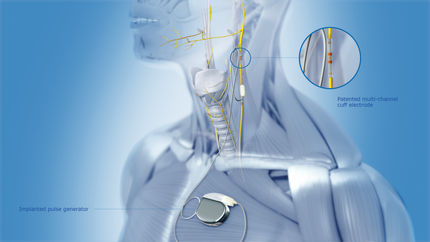Merck and Start-up Inbrain Neuroelectronics Collaborate to Develop the Next Generation of Bioelectronic Therapies
Advertisement
Merck, a leading science and technology company, today announced a second collaboration agreement in its bioelectronics innovation field with Innervia Bioelectronics, a start-up and subsidiary of Inbrain Neuroelectronics S.L., Barcelona, Spain. The aim of the collaboration is to co-develop the next generation of graphene-based bioelectronic vagus nerve therapies targeting severe chronic diseases within the therapeutic areas addressed by Merck.

Second collaboration within the Bioelectronics innovation field of Merck focuses on increasing the selectivity and power efficiency of the device to enable energy intensive neurostimulation using graphene electrodes
Merck KGaA
“We aim to accelerate developments in the emerging field of bioelectronics by boosting the novel modality of selective neurostimulation,” said Laura Matz, Chief Science and Technology Officer of Merck. “Today’s agreement with Innervia Bioelectronics gives Merck access to a unique technology that increases energy efficiency in neurostimulators and could therefore become a true enabler for digital personalized treatment of patients suffering from severe and chronic diseases such as inflammatory disorders.”
Both partners will closely collaborate over the next few years to actively drive this potential paradigm change in treating diseases with high unmet medical needs. With its bioelectronics research facilities, Merck is well equipped and can build on its data science, clinical, regulatory, and quality expertise to bring novel devices to patients in the near future. Innervia will add its technical expertise in the development of graphene interfaces, device development, and signal processing for clinical applications. Initial work will focus on inflammatory, metabolic, and endocrine disorders, using the promising capabilities of graphene for miniaturization, precision, and high modulation efficiency in the vagus nerve.
“This partnership highlights the importance of key players in their respective domains joining strengths to develop electronic therapies based on minimally invasive technologies and precise signal coding, enabled by graphene, for patients with debilitating, systemic, chronic conditions,” said Jurriaan Baker, CTO of Innervia Bioelectronics. “Our shared mission is to improve outcomes for these patients, who live with scarce information about their conditions and little control over their journey,” added Carolina Aguilar, Co-founder & CEO of Inbrain Neuroelectronics.
“Bioelectronic devices have the capability to directly communicate with the nervous system. Recording nerve signals and combining them with other accessible physiological datasets will lead to a better understanding of disease conditions and enable personalized treatment regimens,” said Robert Spoelgen, Head of Bioelectronics, Merck Innovation Center. “We are convinced that bioelectronic devices will play a significant role in the future therapeutic landscape.”
Altered and dysregulated nerve signals occur with many severe chronic diseases. Bioelectronic therapies aim to address a wide range of chronic diseases using small, implantable devices to modulate electrical signals passing along nerves in the body. Furthermore, neurostimulation devices are expected to become increasingly smart as a result of additional features such as continuous readouts, data analysis and data transmission, which will increase the energy use of the device. Yet at the same time, the devices are expected to miniaturize further. These trends are creating significant challenges for the supply of power to these devices. In addition, certain indications have particularly high and continuous power requirements due to the specific disease characteristics. With current technologies, it is extremely difficult to develop viable neurostimulation therapies for these indications.
Improving the energy efficiency of these devices will play an important role in overcoming this power supply dilemma, since alternatives such as energy harvesting are still in their infancy and are far from practical clinical applications. Reduced Graphene Oxide (rGO) offers ideal material characteristics for significantly decreasing power consumption while maintaining stimulation efficacy. This is achieved through a high charge injection limit combined with very low impedance compared with all other available electrode materials. Graphene, a two-dimensional material first isolated in 2004, is made of a lattice of carbon atoms only one atom thick and is the strongest material ever tested at roughly 100 times the strength of an equivalent thickness of steel. Innervia’s technology harnesses the power of graphene, which has unique electrical and thermal conduction properties that are still being explored.
The Bioelectronics innovation field of Merck builds on the company’s experience and expertise in its Healthcare and Electronics business sectors. This collaboration agreement complements a recently announced partnership between Merck, B. Braun and its start-up neuroloop GmbH to evaluate the feasibility of neurostimulator
Other news from the department business & finance
Most read news
More news from our other portals
Something is happening in the life science industry ...
This is what true pioneering spirit looks like: Plenty of innovative start-ups are bringing fresh ideas, lifeblood and entrepreneurial spirit to change tomorrow's world for the better. Immerse yourself in the world of these young companies and take the opportunity to get in touch with the founders.























































